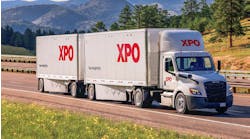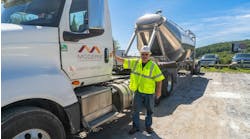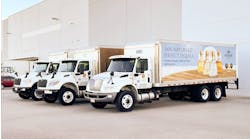Heavy-truck braking systems are evolving, but in what direction and at what pace are questions still cloaked in mists of uncertainty. Only one point along their development timeline stands out in sharp relief: 2009. That's when new federal braking rules go into effect, mandating that tractor-trailers cut their stopping distances by 30%.
Beyond 2009, however, evolution of brakes doesn't depend so much on the white coats in the lab as on the fleet perspective. If fleets think the benefits of new technologies outweigh the price tag, braking systems will change quickly. If they think the costs are too high, the braking evolution may be stunted for years to come.
Fleets are looking for “lower cost, longer life and less weight, without sacrificing performance or increasing maintenance costs,” says Joseph Kay, engineering manager-braking systems for ArvinMeritor. “Less weight will be even more important due to the pounds added by 2007 and 2010 emission control systems.”
Consequently, suppliers have put everything from component materials and metallurgy to brake design and electronics back under the microscope. And if the right combination of technology, materials and design delivers cost savings — as well as consistent, if not improved, performance — fleets may well buy into new braking systems.
Alan Korn, chief engineer for Meritor WABCO Vehicle Control Systems, concurs. “That's been shown with stability control systems. There's no mandate for them, but they're being widely adopted by fleets because there's a payback,” he says.
FOUNDATION OVERHAUL
The basic stopping system for trucks — known as drum, or foundation, brakes — is first in line for a makeover, largely due to the new stopping-distance rule. Finalized by the National Highway Traffic Safety Administration (NHTSA) last March, the rule cuts by 30% the amount of distance a Class 8 tractor going 60 mph can travel before coming to a complete stop. By 2009, all new three-axle tractors must comply with this requirement; specialty tractors have until 2011.
Wider drum brakes are currently seen as the primary solution to shorter stopping distances. “It is the same basic animal we have had out there now for a long time, except that they're wider than standard drum brakes,” notes Jim Clark, director of foundation brakes at Bendix Spicer Foundation Brake.
A number of fleets already spec them because they provide more braking power and offer longer life cycles, thus lowering cost. Clark explains that wider drums, which have more brake lining, allow for a 25% to 50% drop in brake temperature, which means that brake pads will last longer.
New friction materials and coatings for linings that help control heat dissipation also contribute to longer component life.
Experiments with new materials for traditional drum brakes are ramping up as well, although on a more extended timetable, with new products available within the next few years.
W8Less Products is one company experimenting with brake drums made from a metal matrix composite (MMC) composed of aluminum and silicone carbide particles. Dallas Jolley, president & CEO, says that combination gives the MMC material four times the strength of cast iron, which is typically used to make brake drums, while reducing weight by 60%.
Using this lightweight material to make truck brakes is the brainchild of Charles Rau, a trucker himself who owns a California-based sand and gravel transport company. While cast iron drums are durable and wear-resistant, their heavy weight makes maintenance — especially drum replacement — a bear. So using Rau's lightweight composite formulation has the benefit not only of making maintenance easier, but also adding payload capacity back to the vehicle.
However, making drums from this new material is far from easy, says Jolley. “Getting air bubbles out of the material during the casting process is the real trick, as bubbles create weak spots in the metal,” he explains. Rau found that using MMC in the wear surface areas and building the rest of the unit out of a ductile aluminum alloy worked best. Jolley points out that only brake pads made from MMC can be used with MMC drums since using two types of friction materials can degrade brake performance.
“We're going to start out building drums just for lift axles, validating our product in slow steps so everyone is comfortable with it,” he notes.
THE DEAL WITH DISCS
Air disc brakes represent the next big step in braking system evolution, even though they've been available commercially for over a decade in the U.S.
The new stopping-distance rule should actually encourage more use of air disc brakes in the short term, though only on a tractor's steer axle.
In about three to four years, air disc brakes should be more widely used on tractors, but equipping tractors and trailers with air disc brakes on all axle positions probably won't happen for a decade or more, say experts.
“There will definitely be a combination of disc and drum in the immediate future,” says Randy Petresh, vp-technical services for Haldex Brakes. However, he points out that although economies of scale for disc brakes are improving, they still can't match those of drum brakes, which remain far less expensive.
Petresh believes the benefits of air-disc brakes include better performance, expanded service intervals and other maintenance advantages, plus much longer lining life.
“That will tip the scale; disc brakes clearly have the opportunity now,” he says. “Friction materials are moving to more organic materials so air disc brakes can operate at higher temperatures — temperatures where drum brake material can't survive. Drum brake development is mostly maxed out.”
“Longer life with lower maintenance is the key for air disc brakes,” adds Tom Wladyka, Bendix Spicer's director of product and market planning. However, cost will be an issue, he points out. NHTSA estimates that meeting the new stopping-distance standard will add $1,308 to the cost of an air-disc brake, compared to only $153 for a drum brake.
That's also why Haldex's Petresh thinks the switch to air disc brakes will be gradual, at best. Although there could be solid growth over the next four to five years, he says “it will be 10 years before we see significant volumes.”
ELECTRONICS: THE BIG CHANGE
What's really going to open the path for the evolution of truck brakes in the U.S. is electronics, specifically electronically controlled braking systems (ECBS), which, along with air disc brakes, are already widely used in Europe.
However, adoption of ECBS is going to be far down the braking timeline in this country due to something European fleets don't need to deal with: balanced braking. According to Prakash Jain, director-joint venture business development for ArvinMeritor, “Balancing the brake system is not an issue in Europe, but that's the biggest culprit in the U.S
“The 2009 [stopping] rules affect tractors only. That's one reason a fully air disc tractor and trailer is going to be a long time coming,” he says. “There are lots of older trailers out there that don't even have anti-lock braking systems….the challenge for the braking system overall is how these different systems — disc, drum, ABS and non-ABS — all work together on one vehicle.”
Federal mandates requiring ABS on all new trucks, which were phased in during the late 1990s, may have played a role in the delayed adoption of ECBS. ABS allowed OEMs to increase axle braking power, opening the door for wider drum brakes. “ABS prevents the brakes from locking up; once you have a system in place to prevent lockup, you can increase braking power,” says ArvinMeritor's Kay.
In addition, as the gap between ABS and ECBS brake activation times began to narrow, it became even more difficult to convince people that a move to ECBS was necessary. “You're talking about the difference between 2/10th and 3/10th of a second in terms of brake activation between,” says Petresh. “What's the value of an extra of 1/10th of second?”
And with ECBS-based technology priced anywhere from $1,000 to $2,000 more than ABS, it becomes even harder to cost-justify. “If safety isn't being sacrificed, then price sensitivity becomes the determining factor,” says ArvinMeritor's Korn.
ECBS AHEAD
While these issues could delay the adoption of ECBS, they will not prevent it. “There's more and more interest in stability, traction control and anti-rollover systems. Electronics optimize the braking system and are really key to using those systems most effectively,” Petresh points out.
And since air discs are the optimal brake for ECBS, they will undoubtedly be part of any ECBS package. “Electronics can modulate them in ways you can't do with drum brakes, so more electronics means more need for disc brakes,” adds Petresh.
“All brakes will be electronically controlled at some point in the future,” adds Ron Plantan, principal engineer for air disc brakes at Bendix Spicer. “The feeling is this is not 20 to 30 years out; it's much closer than that. An all-electronic braking system is the most evolutionary; it's definitely coming.”


